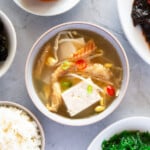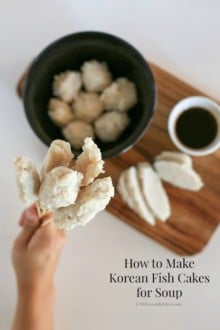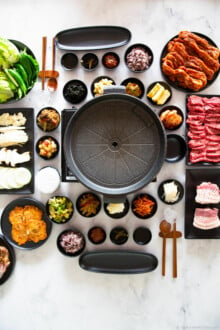Learn how to make dried pollack soup (bugeoguk). This lesser-known Korean soup dish is renowned for its refreshing taste, concentrated flavor, and the chewy texture of the dried pollack. It’s also a popular hangover remedy in Korea.
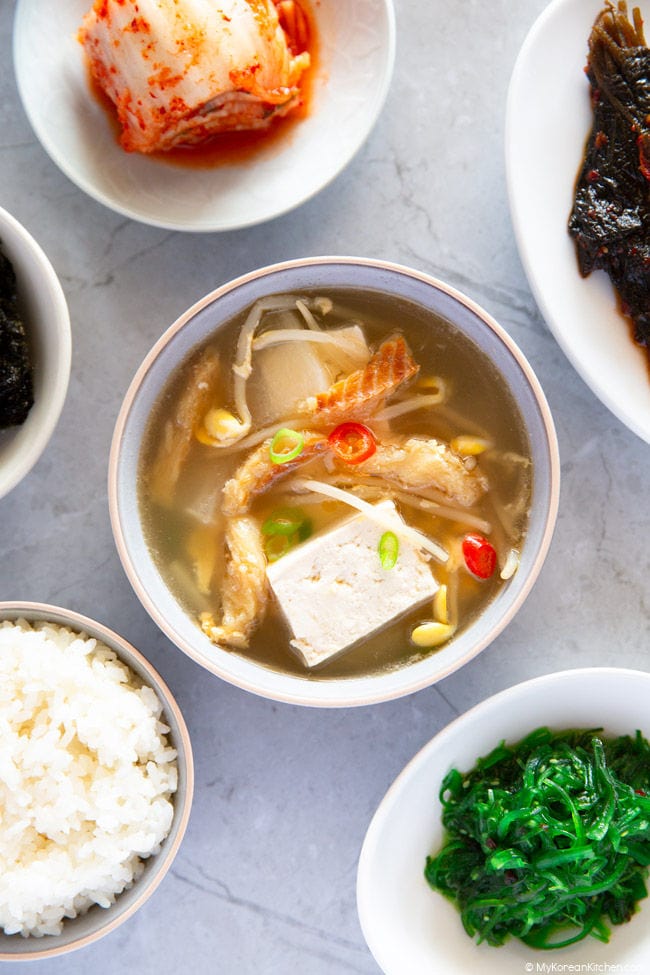
What is Dried Pollack
Dried pollack is a traditional Korean food made from pollack fish, also known as pollock. Both bugeo (북어) and hwangtae (황태) are terms used in Korean cuisine to describe it, but they are not identical.
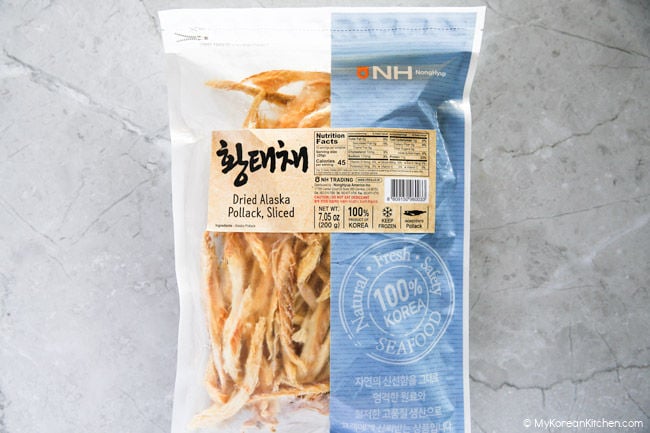
“Bugeo” refers to pollack that undergoes a brief drying process by a sea breeze, whereas “Hwangtae” refers to pollack dried by a mountain breeze. This distinctive drying environment involves the fish experiencing natural freezing and thawing cycles during dry winter, facilitating its gradual drying, resulting in a chewy and spongy texture with a concentrated flavor when rehydrated. This method is also known to give hwangtae a yellowish flesh.
Dried pollack is a staple in many Korean households due to its versatility. It can be used in soups, side dishes, or even enjoyed as is for a drinking snack.
As for storage, I’ve found that keeping it in the freezer helps maintain its freshness, preventing any unpleasant surprises.
What is Dried Pollack Soup
Dried pollack soup, or Bugeo-Guk (북어국), is a savory dish crafted from dried pollack. Its flavor profile is elevated with the infusion of soybean sprouts and radish, contributing a crisp, refreshing taste. Tofu or egg are often included, enriching the soup’s texture and heartiness.
Bugeo and Hwangtae, two types of dried pollack, are staple ingredients in Korean cuisine. Despite their common use, hwangtae is often favored for its distinctive flavor and texture.
Although Bugeo-Guk is the generic term for this soup, regardless of the type of dried pollack used, it can be specifically termed Hwangtae-Guk (황태국) when using hwangtae. This soup is celebrated for its invigorating, detoxifying, and soothing qualities, making it a go-to remedy for hangovers.
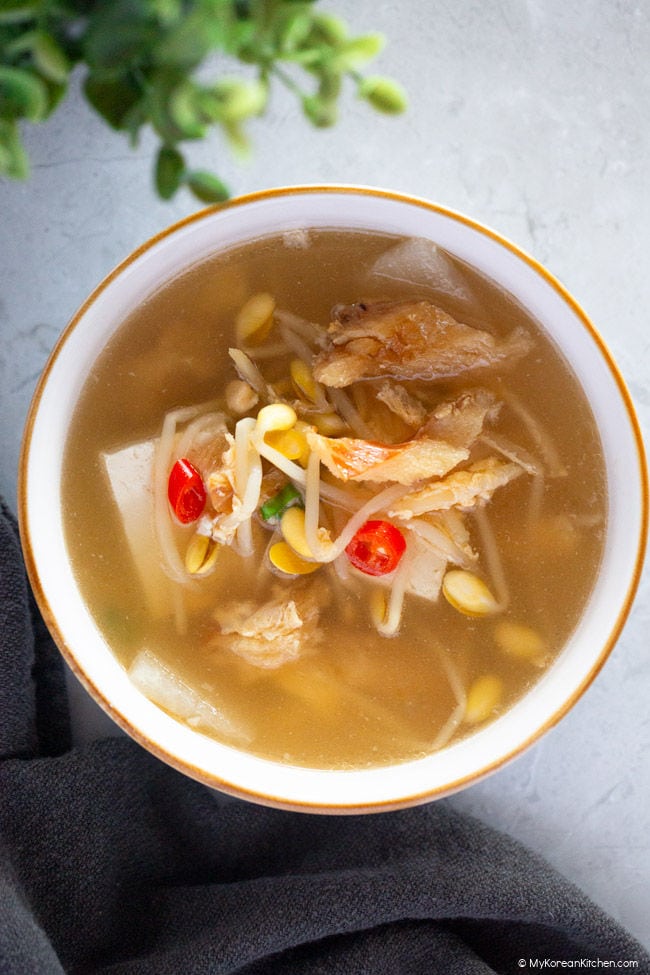
Tips for Making Delicious Dried Pollack Soup
- Avoid Long Soaking of Dried Pollock: You have to moist the dried pollack to make the soup, but to maintain the optimal flavor, avoid soaking the dried pollock in water for an extended period. Excessive soaking may result in the loss of the flavorful essence that will ultimately be discarded.
- Sauté in Sesame Oil: This step will add a nutty aroma to the dried pollack and soup and enhance the flavor of the soup.
- Use Dried Anchovy and Kelp Stock: You can make the soup with just water, but for a more complex flavor, I highly recommend making it with Korean soup stock – dried anchovy and kelp stock.
- Cook it Slowly: After all the ingredients are added, cover and simmer the soup slowly over low heat to let the flavors meld together. Trust me, even though it’s all cooked and OK to eat, it won’t taste as nice as it could if you rush the process! The depth of flavor depends on it.
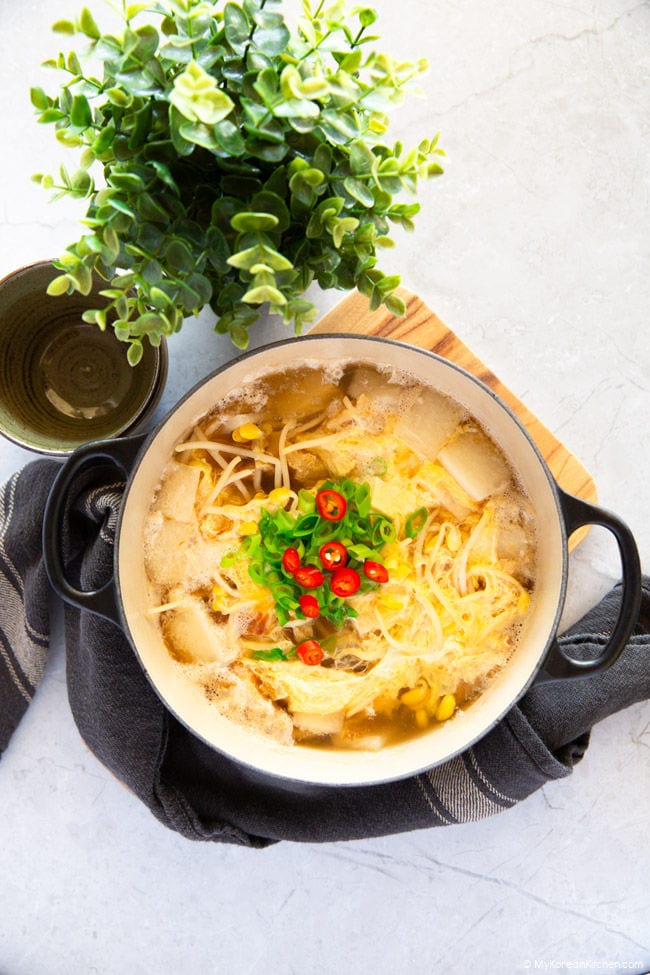
How to Serve
Serve dried pollack soup with a bowl of rice and various Korean side dishes. While any Korean side dish would complement the meal, the image below showcases seaweed salad, pickled perilla leaves, braised lotus root, seasoned dried seaweed, and napa cabbage kimchi, which I find to be especially great combinations.
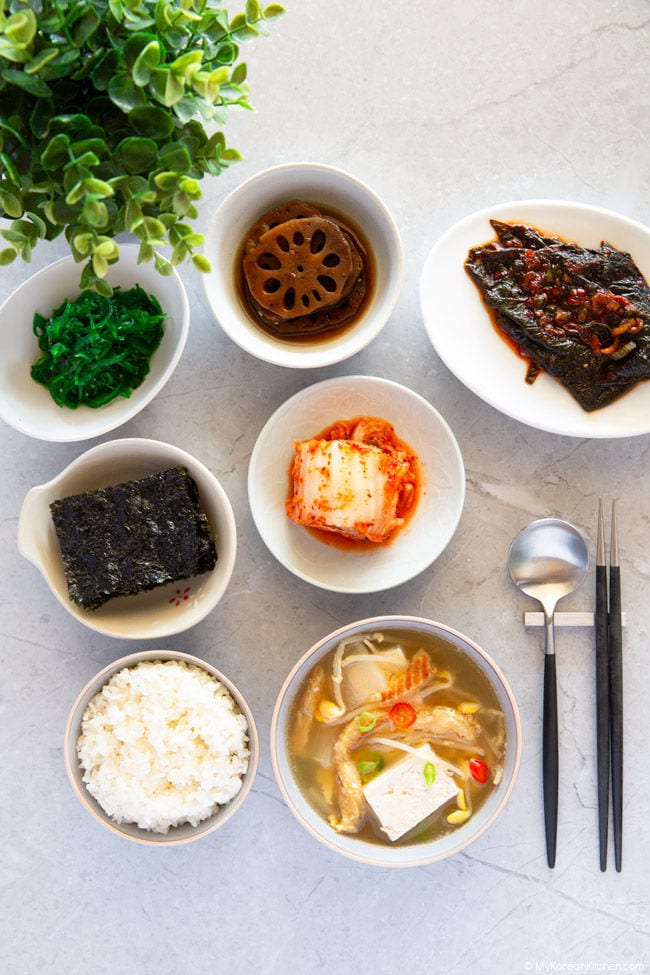
Other Delicious Korean Soup Recipes You Might Like
If you want to try Korean soups with a taste profile similar to that of dried pollack soup, check out the recipes below!
Ingredients for Dried Pollack Soup

- 50 g / 1.8 ounces dried pollack
- 100g / 3.5 ounces Korean radish or daikon radish, peeled & thinly sliced
- 1 Tbsp toasted sesame oil
- 1 tsp minced garlic
- 5 cups Korean soup stock (dried anchovy and kelp stock)
- 1 Tbsp Korean soup soy sauce (or Kikkoman regular soy sauce, but this will make the soup look darker.)
- 1/2 tsp fine salt, or to taste
- 150g / 5.3 ounces tofu, cubed
- 100g / 3.5 ounces soybean sprouts
- 10g / 0.4 ounce green onions, thinly sliced
- 2 eggs, beaten
- (optional) ground black pepper, to taste
- (optional) green or red chilies, thinly sliced & seeds removed
* 1 Tbsp = 15 ml, 1 Cup = 250 ml
** If you want to learn more about Korean ingredients, check my essential Korean ingredients list.
How to Make Dried Pollack Soup
1. Submerge the dried pollack strips in a bowl of water a few times and rinse them gently. Strain the water away. It won’t take long for the dried pollack strips to reconstitute. Scan the hydrated pollack one strip at a time and checking for any fiddly bones that may be stuck on the pollack. Pull the bones out and remove as you find them. This can be a bit of a tedious process, but it is necessary for your fine dining pleasure. The pollack will feel like a wet sponge. Cut the pollack with scissors in 4cm (1.6 inch) lengths.
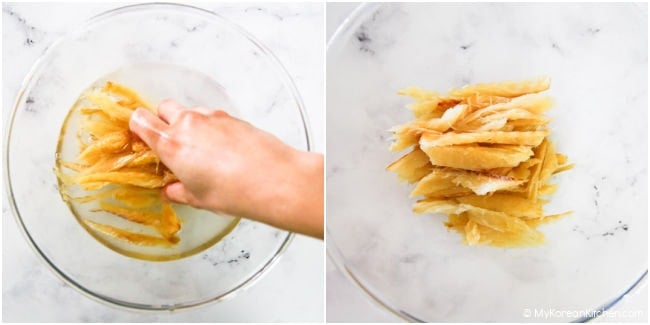
2. In a well heated, heavy based pot, add the sesame oil, pollack and minced garlic and sauté for 2 to 3 minutes over medium high heat. Add the radish and sauté for 3 to 5 minutes over medium high heat.
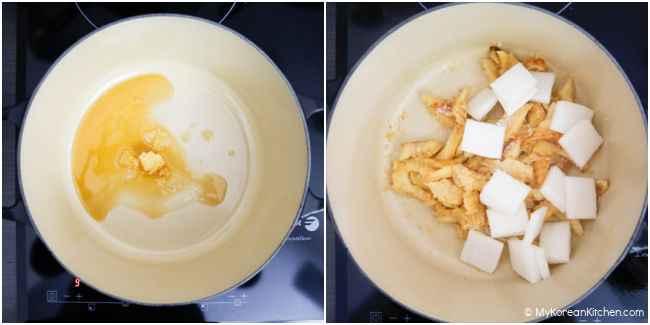
3. Add 1 cup of soup stock and boil for 3 to 5 minutes over medium high heat, covered.
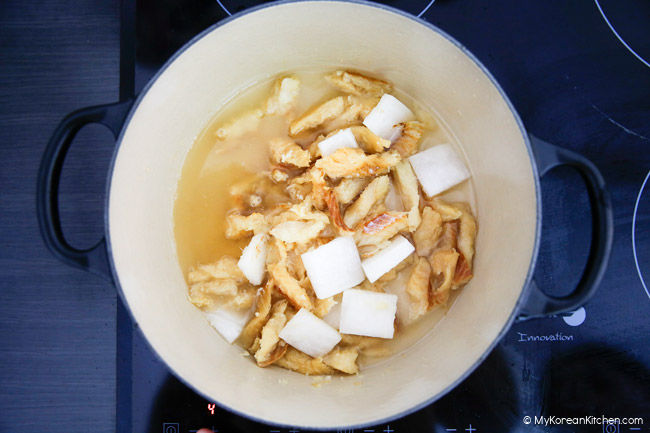
4. Open the lid, add the rest of the soup stock (4 cups) and season the soup with Korean soup soy sauce and salt. Reduce the heat to medium low and simmer for an additional 10 minutes, covered.
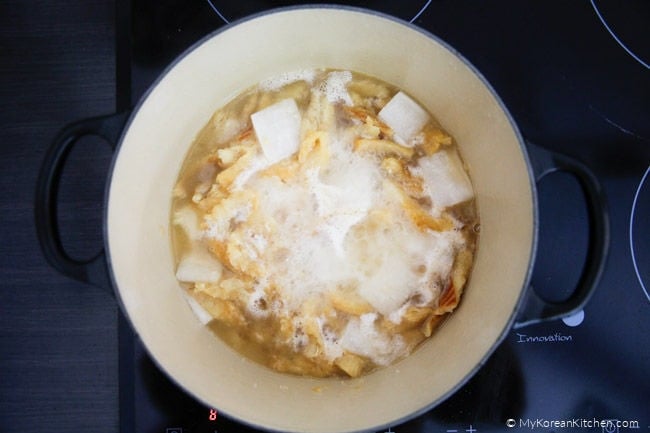
5. Add the tofu and soybean sprouts. Boil over medium high heat until it reaches a rolling boil, which should take approximately 3-5 minutes. Next, add the egg and stir it into the mixture. Finally, garnish with green onions and red chilies.
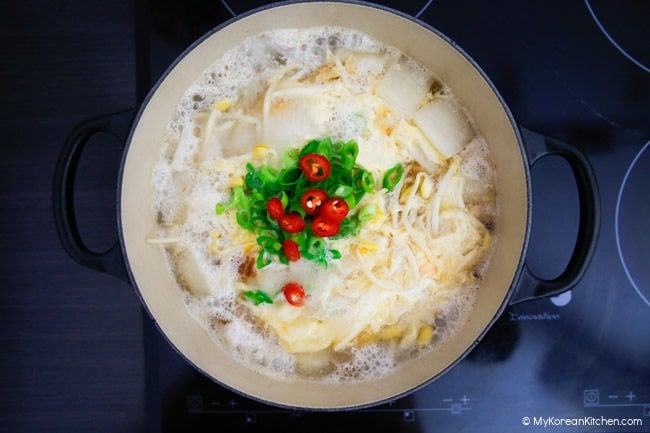
6. Serve the soup with a bowl of rice, kimchi and other Korean side dishes.
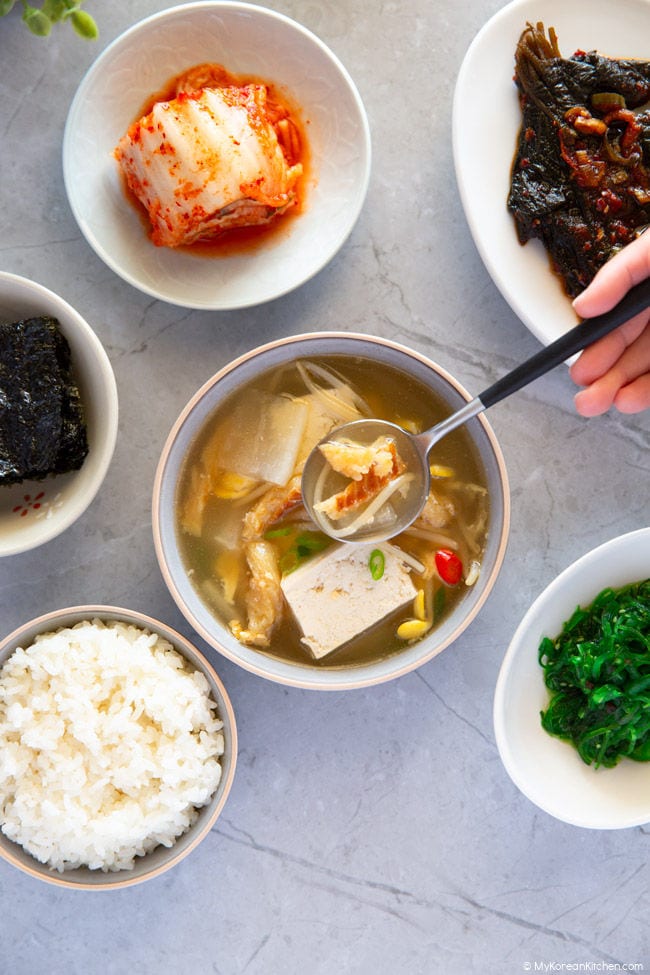
Love Korean food? Explore our site for more authentic Korean recipes including how to create a perfect Korean BBQ at home or other easy Korean dishes. Also, never miss a new recipe by subscribing to our newsletter, and join us in celebrating Korean cuisine!
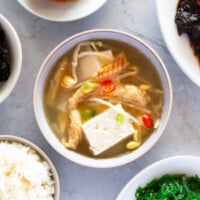
Dried Pollack Soup
Ingredients
- 50 g dried pollack (1.8 ounces)
- 100 g Korean radish or daikon radish (3.5 ounces), peeled & thinly sliced
- 1 Tbsp toasted sesame oil
- 1 tsp minced garlic
- 5 cups Korean soup stock (dried anchovy and kelp stock)
- 1 Tbsp Korean soup soy sauce (or Kikkoman regular soy sauce, but this will make the soup look darker.)
- 1/2 tsp fine salt , or to taste
- 150 g tofu (5.3 ounces), cubed
- 100 g soybean sprouts (3.5 ounces)
- 10 g green onions (0.4 ounce), thinly sliced
- 2 eggs , beaten
- ground black pepper , to taste (optional)
- chilies (green or red), (optional), thinly sliced & seeds removed
Instructions
- Submerge the dried pollack strips in a bowl of water a few times and rinse them gently. Strain the water away. It won't take long for the dried pollack strips to reconstitute. Scan the hydrated pollack one strip at a time and checking for any fiddly bones that may be stuck on the pollack. Pull the bones out and remove as you find them. This can be a bit of a tedious process, but it is necessary for your fine dining pleasure. The pollack will feel like a wet sponge. Cut the pollack with scissors in 4cm (1.6 inch) lengths.
- In a well heated, heavy based pot, add the sesame oil, pollack and minced garlic and sauté for 2 to 3 minutes over medium high heat. Add the radish and sauté for 3 to 5 minutes over medium high heat.
- Add 1 cup of soup stock and boil for 3 to 5 minutes over medium high heat, covered.
- Open the lid, add the rest of the soup stock (4 cups) and season the soup with Korean soup soy sauce and salt. Reduce the heat to medium low and simmer for an additional 10 minutes, covered.
- Add the tofu and soybean sprouts. Boil over medium high heat until it reaches a rolling boil, which should take approximately 3-5 minutes. Next, add the egg and stir it into the mixture. Finally, garnish with green onions and red chilies.
- Serve the soup with a bowl of rice, kimchi and other Korean side dishes.
The nutrition information shown is an estimate provided by an online nutrition calculator. It should not be considered a substitute for a professional nutritionist’s advice.
